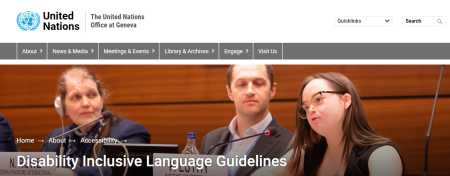United Nations Geneva - Disability Inclusive Language

“This document contains recommendations that United Nations staff, experts and collaborators can use in their oral and written communications on disability or other subjects, including speeches and presentations, press releases, social media posts , internal communications and other formal and informal documents. It is based on an in-depth study of disability-inclusive language materials and a consultation process with a diverse range of experts, including persons with disabilities.
Words matter. Undeniably, the language that we use to refer to persons with disabilities has an impact, as it shapes our perception of the world. This language has evolved over time, and terms that were commonly used some years ago are no longer acceptable. It is therefore important to raise awareness about language that it is appropriate to use when talking to or about persons with disabilities. Inappropriate language can make people feel excluded or offend them and can be a barrier to full and meaningful participation. The use of derogatory or inappropriate language may amount to discrimination and impinge on the enjoyment of human rights. By adopting language that celebrates diversity, we will contribute to strengthening the human rights model of disability and to creating a more inclusive United Nations.
At the same time, inclusive language is a key tool in combating ableism and its entrenched manifestations. Ableism is a misguided and biased understanding of disability that leads to the assumption that the lives of persons with disabilities are not worth living. Ableism can take many forms, including harmful language.
In terms of language and terminology, the United Nations Convention on the Rights of Persons with Disabilities sets the standard that we must all follow. The general comments issued by the Committee on the Rights of Persons with Disabilities, together with other authoritative United Nations documents, also provide guidance to better understand the Convention and its language.
These practical guidelines aim to foster the consistent use of respectful language at the United Nations. They contain the general principles that should be applied, and are intended to be practical and easy to use. Annex I contains a table summarizing both the recommended terminology and the terms that are considered inappropriate. Annex II consists of a list of terms that require additional clarification from a language perspective in order to avoid common mistakes and to comply with United Nations terminology standards.”
